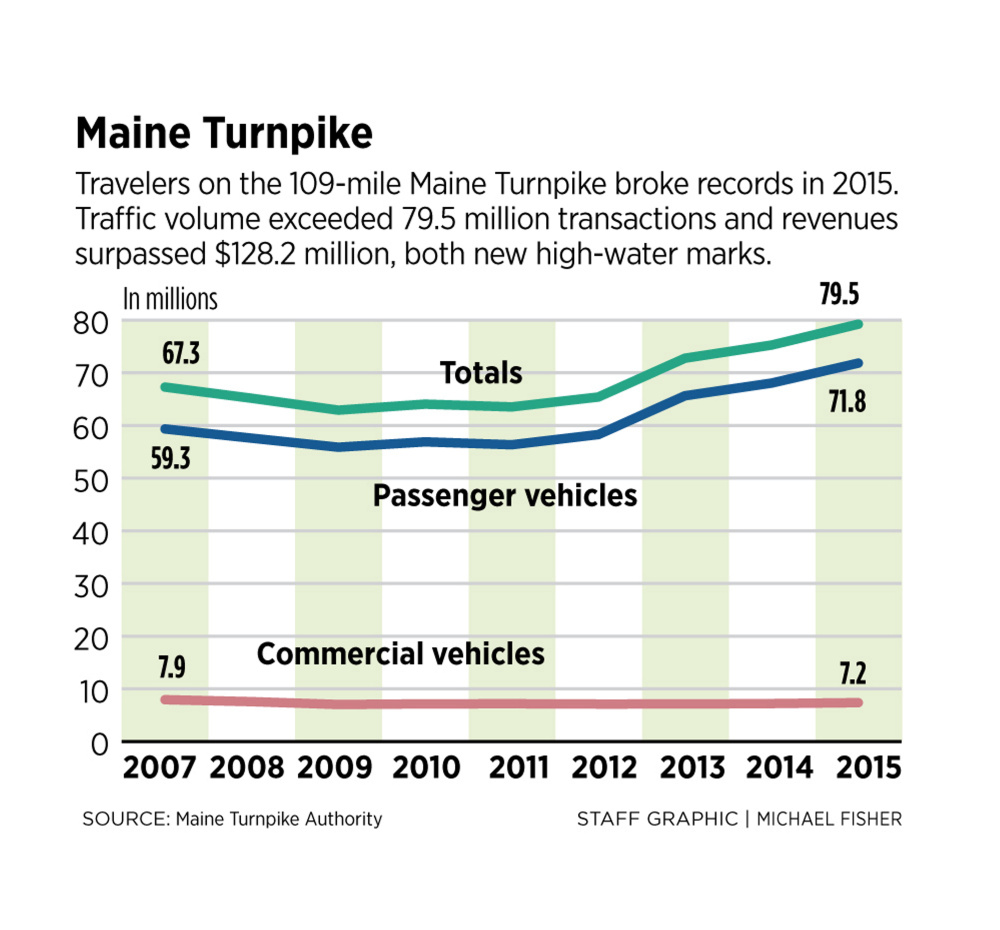More cars and trucks whizzed through tollbooths on the Maine Turnpike in 2015 than in any year in its 69-year history, a strong indication that the state’s economy is returning to pre-recession strength and accelerating plans to widen the highway through the Portland area.
Despite a brutal winter that battered roads almost weekly – driving $1 million in extra salting costs and keeping motorists off the highway – the Maine Turnpike Authority still bested its previous record set in 2007, before the Great Recession took hold across the nation, according to turnpike data requested by the Press Herald last week.
Traditionally, traffic levels on the turnpike, the state’s transportation backbone, are an early indicator for Maine’s overall economic health – be they tractor-trailers transporting goods into and out of the state, or summertime vacationers and winter skiers.
“Traffic is back,” said Peter Mills, the authority’s executive director. “To the extent that we are a harbinger of success for the Maine economy, hang on to your hats.”
More than 79.5 million drivers paid tolls in 2015, besting the 2007 record of just over 76 million transactions, said Douglas Davidson, the authority’s chief financial officer.
The heavy traffic translated into $128.2 million in revenue, an increase of $4.59 million from 2014, putting the agency well ahead of its expected growth targets.
“It was our banner year,” Davidson said, “and it has not slowed down.”
Through most of January, total traffic was up 5.3 percent and revenue was up 5 percent compared with the same period last year, Davidson said.
Also evident in the year-end figures are emerging patterns of driver behavior in the Portland region, Mills said.
The turnpike authority is seeing an increase in shorter trips within the areas around Portland, indicating that drivers are using the highway instead of local roads. As a result, the authority is considering advancing by several years a road-widening project that could expand the turnpike to six lanes through the Portland area and at least as far north as Falmouth.
Currently, after Exit 44 – just south of Portland – the highway narrows to four lanes.
Long-term plans had called for starting the widening project sometime after 2020, but it could be moved up so that work would begin before then, Mills said.
“The recession came along and we thought, ‘Well, OK, we don’t have to think about that for another five or 10 years,” Mills said. “But it’s come roaring back.”
The authority expects to have a firmer idea on the time frame for a Portland-area widening project in March. Its previous widening project – a 30-mile stretch from York to Scarborough – was completed in 2004.
For this year, the turnpike authority intends to continue working on the design of its new York toll plaza at mile 8.8. Construction work on the $40 million project is expected to begin in the spring of 2017.
The new plaza, which drew opposition from some York residents who wanted it built in another location, will allow motorists to pay cash at booths or to pay electronically with an E-ZPass by using highway-speed center lanes, such as those on Interstate 95 in Hampton, New Hampshire.
Despite sluggish figures in January and February of 2015, turnpike traffic surged in March and held steady through the end of the year. At the peak of the tourist season in July and August, 8.6 million and 8.7 million transactions were recorded, respectively, an increase of 730,000 toll charges over the same two months of 2014.
According to turnpike authority studies, roughly 80 percent of Maine tourists arrive in the state by vehicle.
Commercial truck traffic also increased across the board to 7.39 million transactions, up by more than 172,000 trips in 2015 over 2014 traffic.
Dana Connors, president and CEO of the Maine Chamber of Commerce and a former Maine transportation commissioner, said traffic rates on the turnpike have tracked relatively closely with the state’s overall economic performance.
He noted that increased revenue by the state, through sales and income taxes, show a buoying of the state economy.
“There is an increased confidence in the minds of people, whether it’s a business or an individual,” Connors said. “The signs indicate that it’s not just attitudinal.”
After revenue and transactions bottomed out in 2009, traffic stagnated for a time and then began climbing in 2012, Davidson said.
Another factor in the traffic increase is the cost of gasoline, which has declined rapidly in the past two years, allowing drivers more financial leeway to take long trips.
At the beginning of 2014, the average price of a gallon of unleaded regular was above $3.40, according to gasbuddy.com, which tracks retail gasoline prices nationwide. A year later, in January 2015, that average cost was down to about $2.10. After a spike last summer, prices have continued to fall. Today, unleaded is below $2.
Send questions/comments to the editors.




Success. Please wait for the page to reload. If the page does not reload within 5 seconds, please refresh the page.
Enter your email and password to access comments.
Hi, to comment on stories you must . This profile is in addition to your subscription and website login.
Already have a commenting profile? .
Invalid username/password.
Please check your email to confirm and complete your registration.
Only subscribers are eligible to post comments. Please subscribe or login first for digital access. Here’s why.
Use the form below to reset your password. When you've submitted your account email, we will send an email with a reset code.